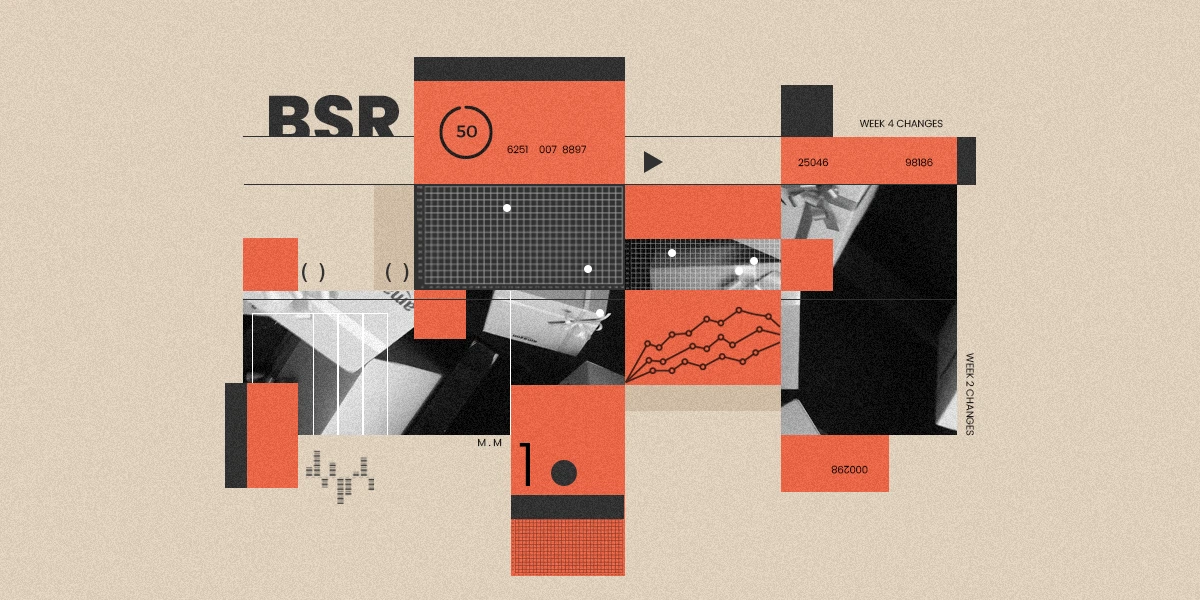
All You Need to Know About Amazon Product Ranking


Table of Contents
- What Is Amazon Product Rank?
- Why is Amazon Product Ranking Important?
- How to Improve Amazon Product Ranking?
- What Is the Best Sellers Rank?
- How Can I Locate My Product’s Best Sellers Rank?
- What Insights Can Best Sellers Rank Give Me?
- Xray Shows Your Product’s BSR From the Beginning of Time
- Why Does Search Volume Matter?
- Putting Software Tools to Work
- Using “Xray” View to See What’s Really Happening
- Okay -- if not BSR, then what?
- Keyword Tracking Best Practices
- Stay Vigilant
It’s true. A great listing can do wonders for you, but only IF you have the traffic to back it up.
That’s why when it comes to selling on Amazon, leveraging existing traffic is one of the most valuable and actionable steps you can take to increase your conversion rates.
The United States Amazon marketplace has millions of products. Yet, only seven pages of results return each time a customer inputs a search term into Amazon’s search bar. Very few customers make it to the last page of the search results.
A higher Amazon product rank in search results can be the difference between nonexistent sales and outstanding sales.
While some sellers turn to PPC advertising to get in front of more prospective consumers to scale their business, others use rebates to encourage those same consumers to search, find and buy their products.
Many Amazon sellers focus on their own or their competitors’ product Best Seller Rank (BSR). But what are the best metrics to look at when ranking your product?
- Can ranking higher on an Amazon Best Sellers list really help you?
- How essential is BSR?
- What is BSR?
- If the Best Seller Rank is not the most crucial metric to Helium 10’s Director of Training, Bradley Sutton, then what is?
These are all great questions. Let’s walk through them.
What Is Amazon Product Rank?
Amazon Product Rank is the ranking position of your product in the organic Amazon search results. It is determined by Amazon’s A9 product search algorithm, which is much different than Google’s. When a buyer searches for a specific product on Amazon, the results are delivered through a two-step process. One, the relevant products are pulled from the Amazon catalog. Two, they are ranked according to relevancy.
Note: products do not have a single ranking number, as your product could rank differently for different keywords.
Why is Amazon Product Ranking Important?
Amazon Product Ranking acts as an important status of your product’s visibility to your customers. This is similar to the way you would want your website to show up on the first page of search results pages for target keywords. Failure to optimize your product listings and achieve high-ranking positions will result in less traffic and fewer sales.
More visibility = more sales
More sales = higher Amazon Best Sellers Ranking
How to Improve Amazon Product Ranking?
Amazon Best Seller Rank works much like organic Product Rank and finessing the two rankings could mean big success. Amazon Sales Rank is based on consistent daily sales. Being more intentional with your product listing will always have a positive effect on your Amazon Product Rank.
3 Tips to Improve Your Amazon Product Ranking
- Perfect your product title. The product title is the face of your product and the first thing customers notice. Not only should it be optimized according to the best practices of SEO, but you need to make sure that it matches what shoppers are looking for and instantly grabs their attention
- Optimize your product description. The secret to an effective product description is to make your product sounds unique. Highlight any competitive differentiators and the key pain points the product is intended to solve. And, of course, don’t forget to include the target keywords.
- Promote your Amazon listing. You can improve your Amazon Best Seller Rank by driving more traffic and sales to your product page. You can do this by running limited-time sales events, offering coupons, using Sponsored Products ads, or driving external traffic through Google Ads.
What Is the Best Sellers Rank?
One way that Amazon drives sales is through tracking and publicizing its best-selling products. Every product has a product ranking on Amazon in least one category and several subcategories, typically once your ASIN/product has sales history.
Calculated based on all-time sales of an ASIN/Product in which recent sales are weighted more than older sales, ranking is inversely proportional to sales with a lower Amazon best seller rank indicating greater sales.
The Best Seller Rank is updated every hour and, as a result, fluctuates widely, with the list being updated often. This means that on the day that your product accumulates more sales, as a seller, you may see your product’s BSR drop just as when your sales velocity decreases, your product’s BSR may rise.
In the case that your product’s BSR remains steady, the maintenance of your rank may be attributed to other products in the same category also experiencing the same upward or downward movement.
Nevertheless, it is commendable that the Best Sellers Rank is a feature completely unique to Amazon! Visit the website of any standard retailer like Walmart or Target, and you will quickly discover no best seller rank is provided, leaving buyers and sellers alike with an inability to differentiate what the best selling products truly are. The quality of products must be sorted manually based on reviews, and product opportunity is left speculative.
Not to mention that without BSR, companies like Helium 10 would also have no way to provide accurate estimates on sales as the information is directly derived from best seller ranking history and how the BSR for products changes every day.
How Can I Locate My Product’s Best Sellers Rank?
BSR can be located in three spots:
- Under Product Details on the product listing page
Or if you are using the Helium 10 Chrome Extension:
- On the main search results page on top of the product
- Inside of Xray
For example, if I were to type skincare oil into the Amazon search box and come across the Bio-Oil Skincare Oil in the search results, I would be able to conveniently spot the best-seller rank for that main category and subcategory right above the title on the search results page. (As long as the Helium 10 Chrome Extension was installed on my Google Chrome browser)
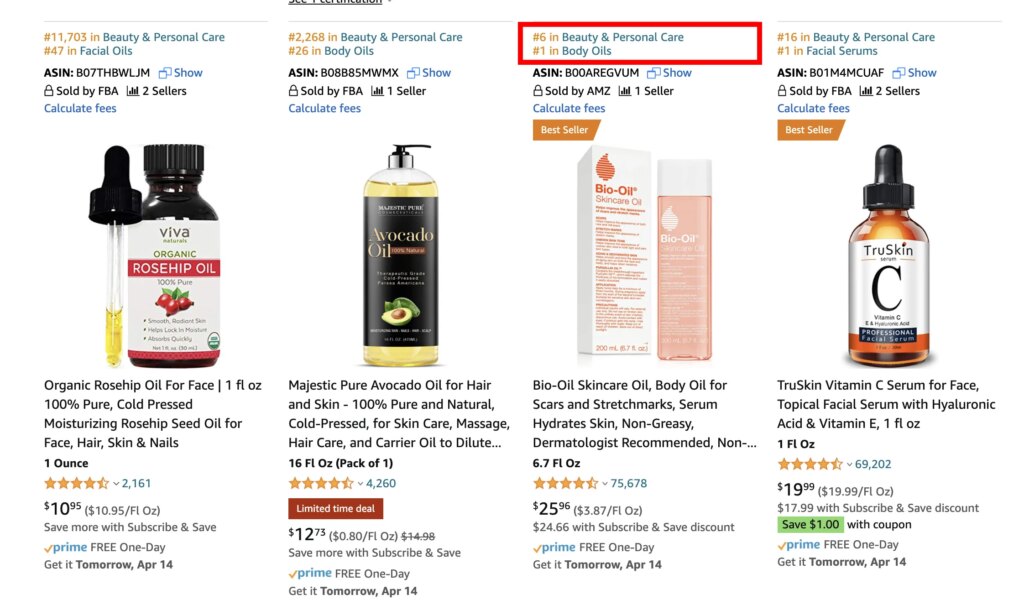
If I did not have the extension downloaded, all I would need to do to discern the Amazon best seller rank of the given product is click the product image on the search results page. I would then be directed to the listing and be able to scroll down to product details where BSR is indicated below the ASIN. (A reference image is pictured below)
In regards to BSR, it is worth noting that Amazon made a change last year where variation listings only showcase one Amazon best seller rank to reflect the combined sales of all its child variations together. For example, take a look at the Amazon product listing for this Bio-Oil Skincare Oil that comes in five size variations.
If we individually selected the 3 Count, 0.85 Fl Oz Bottle, and scrolled down to the Product Details area, as mentioned before, we would find the Best Sellers Rank for the given product underneath the ASIN. The Best Sellers Rank for the chosen size is #6 in the category Beauty & Personal Care.
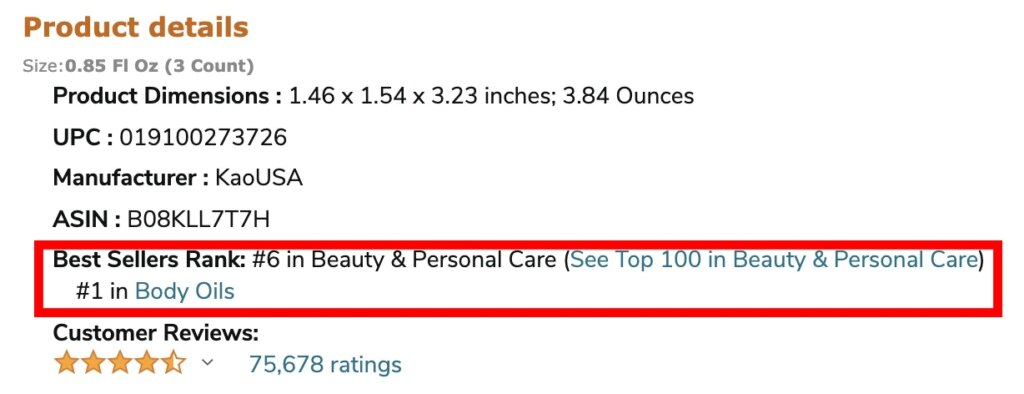
But if we select a different variation, the 2 Fl Oz bottle underneath the same skincare-oil listing, the product details still indicate the exact same BSR.
Both variation product listings showcase a BSR of #6 in the category Beauty & Personal Care while being #1 in Body Oils.
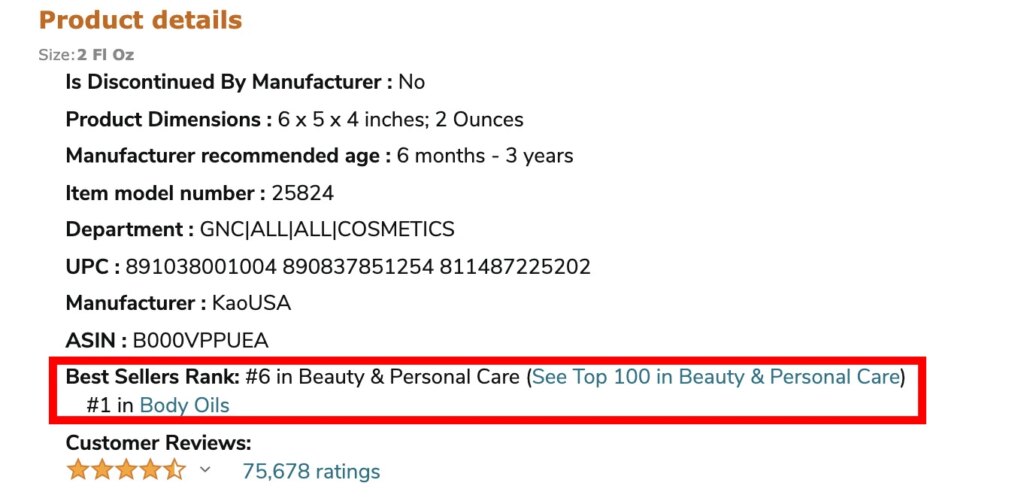
The third way to identify the Amazon best seller rank for a product is by using Xray, Helium 10’s product research tool for Amazon available in the Chrome Extension.
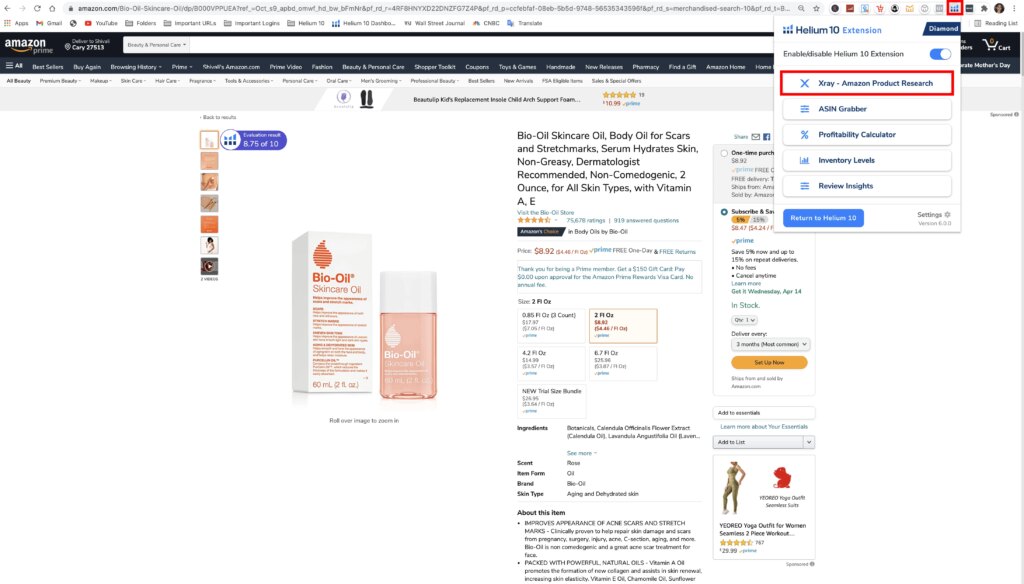
Whether on the main search results page or on the product page, we can utilize the tool to exhibit the same information without necessarily having to navigate to each page individually.
Translation?
For parent listings with child variations, each child item has the same BSR as the parent listing with the same sales estimate. The tool does not mean each variation is making 49,249 sales per month, but rather that this listing with the child items denoted by different ASINs combined together is generating a total of 49,249 sales.
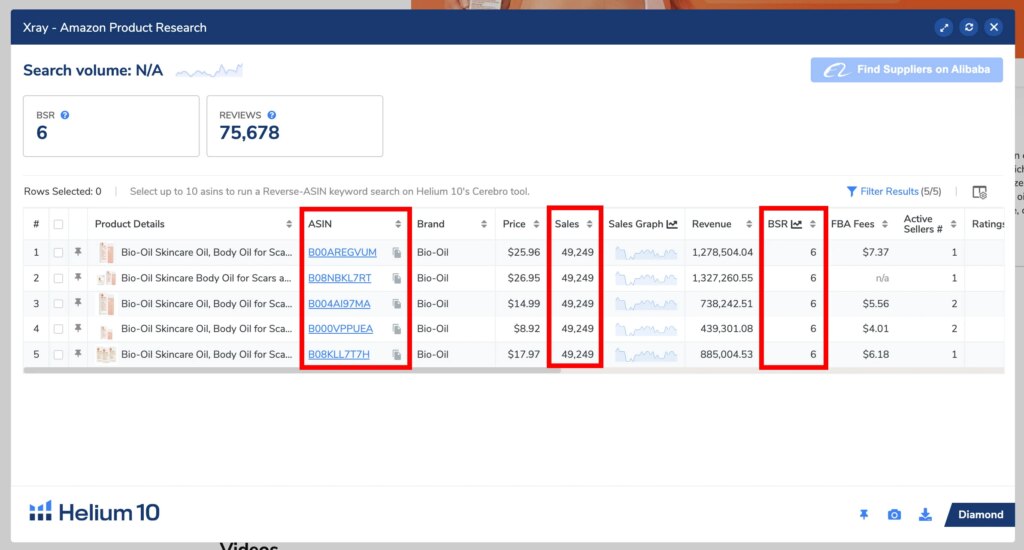
What Insights Can Best Sellers Rank Give Me?
Now that you know what BSR is, and that child variations depict the same BSR across the board, perhaps you are curious as to what insights BSR can really give you.
I’m glad you’re thinking about it! To answer that question, quite a few!
For starters, you can discover when competitors have gone out of stock and/or stayed out of stock. Take a look at Manny’s Mysterious Oddities coffin shelf.
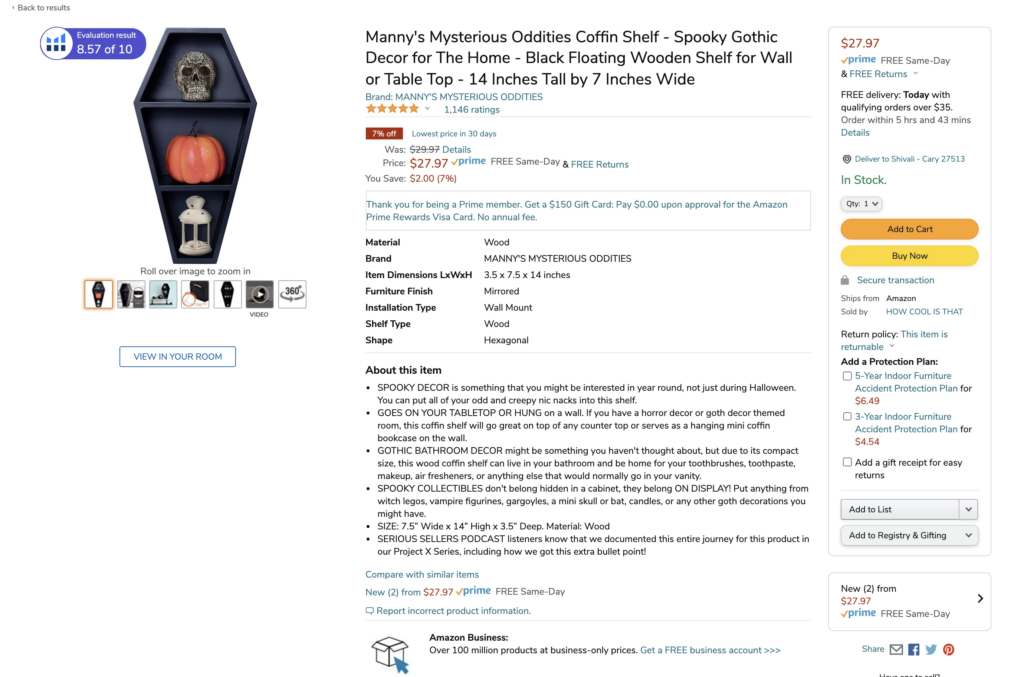
By clicking on the Chrome Extension, selecting the Xray tool, and clicking on the BSR graph, you can take a look at the product’s BSR history.
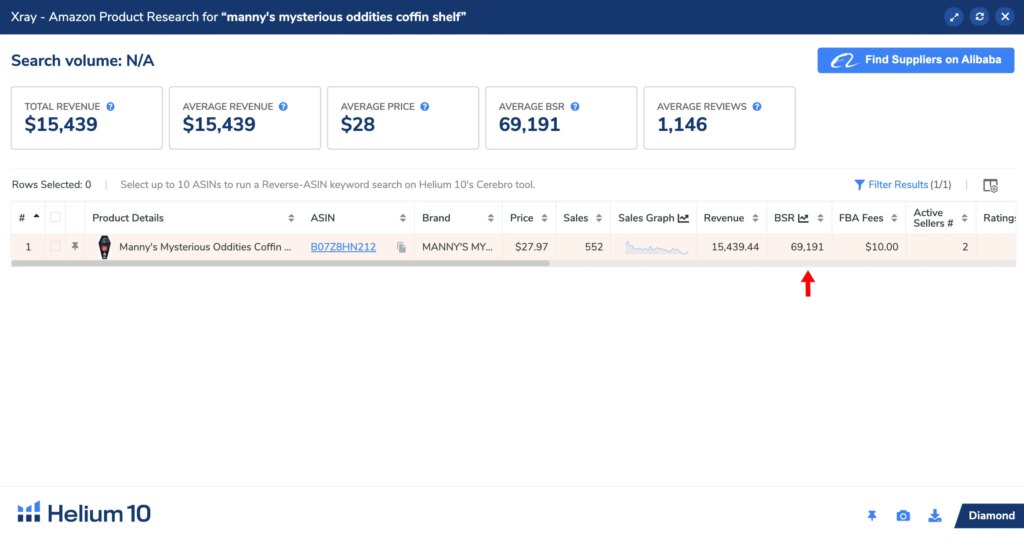
The All Time graph displays Amazon sales rank went from 49,352 on December 12th, 2019 to 840,969 on February 20th, 2020. That is a drop of over 790,000 points in that time span with several dips in between. The data suggests a corresponding decrease in inventory.
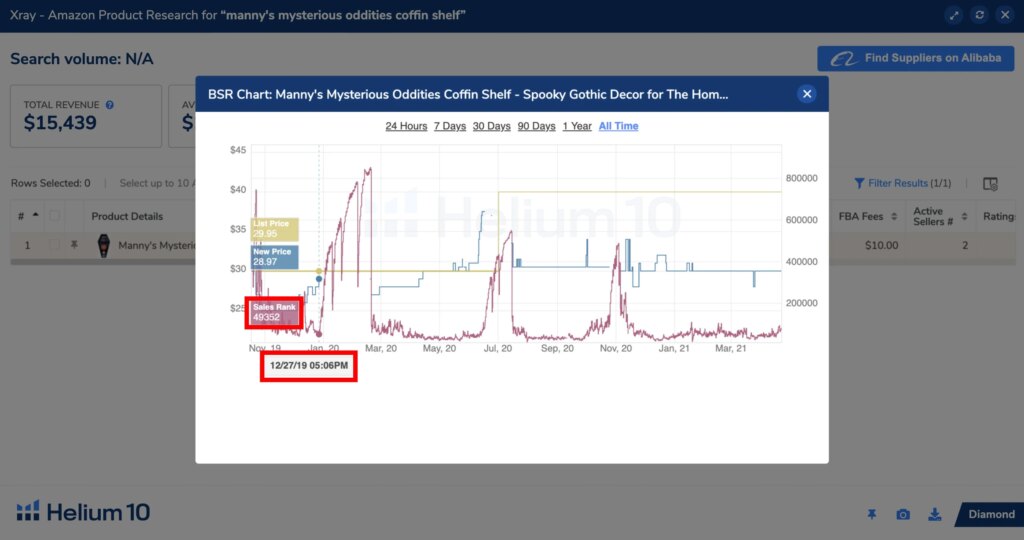
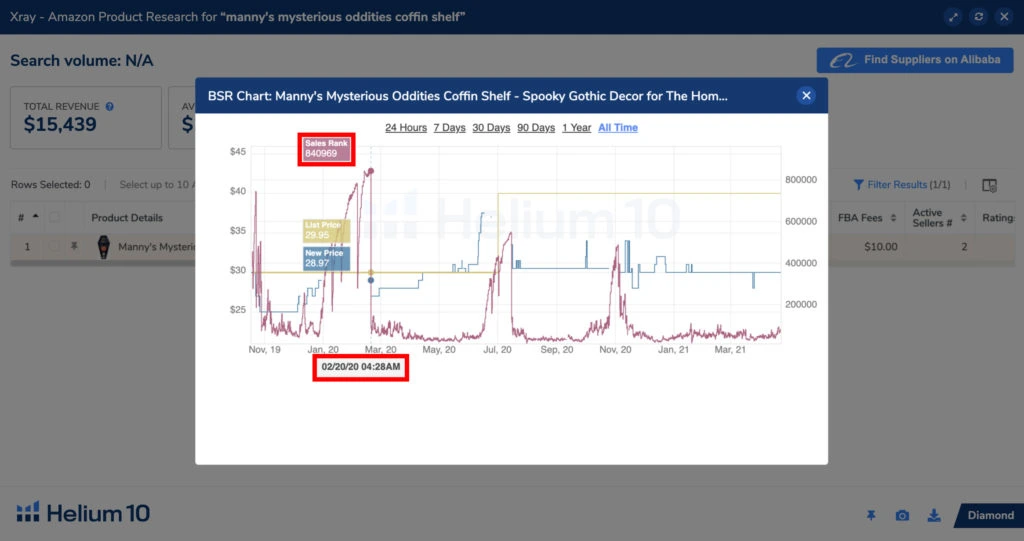
The brief dips could imply an item coming back into stock whether through a return or another avenue before going out of stock again until about February 22nd, 2020. As you can see below, the BSR dropped back down to 57,606 on February 21st, 2020 suggesting a ramp up in sales.
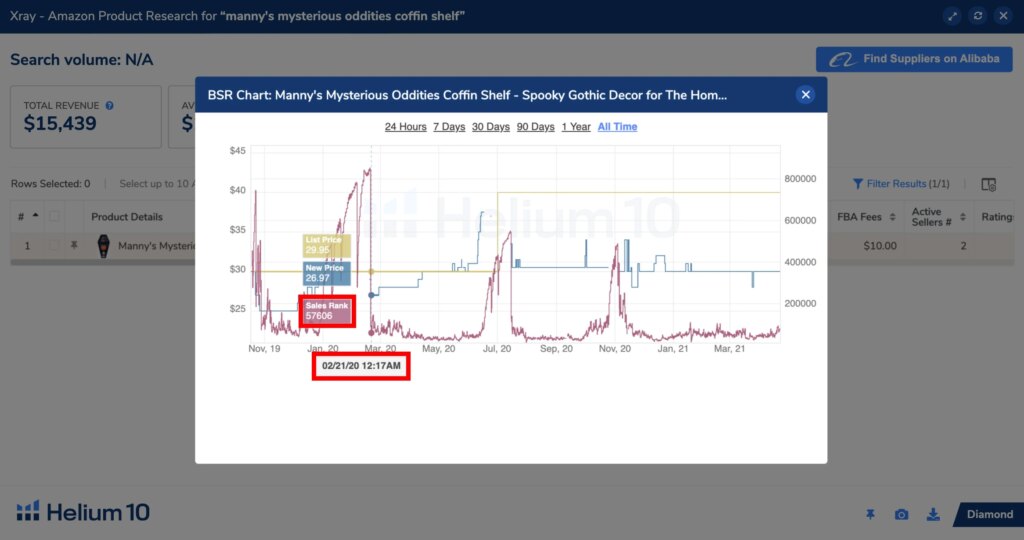
Being aware of when your competitors are running out of stock or currently out of stock can serve you well if you are in the midst of deciding on whether or not to embark into that market. Having competitors out of stock can indicate opportunity while simultaneously guide you towards the optimal pricing of your product!
Xray Shows Your Product’s BSR From the Beginning of Time
You can track when the product was first launched by selecting All Time at the top of the product’s BSR graph.
The graph above illustrates the coffin shelf we were looking at initially launched in October of 2019. However, there would be no way we could have identified that for a standard product without access to the Helium 10 Chrome extension tool.
You can use the historical numbers of BSR to help you search for relevant keywords to use in your listing.
I know what you’re thinking…whaaaaat?! How?!
Having the right Amazon keywords can boost your ranking, and here’s an advanced tactic how you could go about using the historical data behind BSR to discern those ‘right’ Amazon keywords that literally no one is talking about.
If you wanted to identify important keywords for the following product, first, you could run Cerebro, Helium 10’s in-depth competitor keyword and phrase research tool.
By inputting the corresponding ASIN (B087CDJMBM in this case) found under the Product Details section on the product page into our tool, you would be able to use Advanced Filters to establish relevant keywords that are semi-high search volume.
Why Does Search Volume Matter?
Search volume represents the estimated number of customer searches that are occurring for a specific product using the same keyword (s) per month.
For our example, I entered a minimum of 1000 using the Advanced Search Filters tab. That’a because a higher customer search volume would be beneficial in getting the listing in front of more prospective buyers.
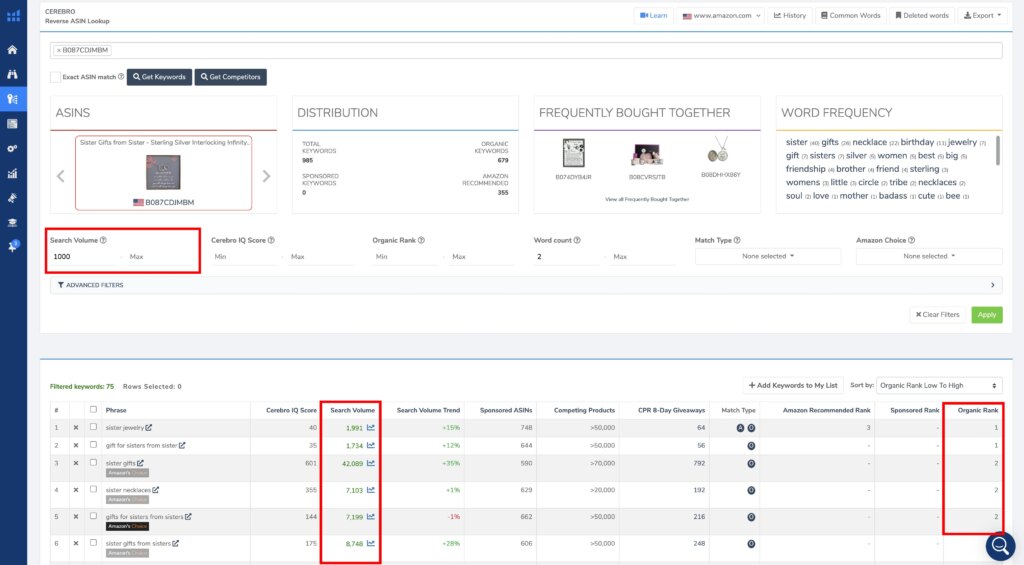
You could then take a look at the top five and the associated organic rank of the product for that keyword. The organic rankings being relatively high combined with a high customer search volume can convey the keyword or key phrase is of significance and being searched for at least 1,000 times per month (in this scenario) on Amazon.
Now, what would I do after I saw a competitor ranking for a high search volume keyword that perhaps I didn’t know or recognize they were ranking for before? The first thing I would want to know is when did they start ranking for that product.
Putting Software Tools to Work
You can do this by adding the product and the keyword in question to Keyword Tracker.
Helium 10’s Amazon keyword ranking tool tracks movement in Amazon product rank for different keywords and key phrases.
To track any product, just click Add New Product in the top right-hand corner of Keyword Tracker and enter in your product of interest and associated keywords/keyphrases to start tracking!
Once the keywords or key phrases have been added, you can go back in history to see if Helium 10 has search volume on it.
To check the history, select the graph icon under actions, and a chart like the one pictured below will pop up.
Here, the image depicts the example product was ranking for the keyword, ‘sister necklace’ approximately at position 269 in April of 2020. It eventually gained sales velocity for the high customer search volume keyword and remained steady on page one starting somewhere between June to July of 2020.
Using “Xray” View to See What’s Really Happening
When we compare the Amazon keyword graph to the BSR history graph we find using Xray in the Helium 10 Chrome Extension on the product page, we can see there was a significant drop in Amazon sales rank from 244688 in May 2020 to 37931 June 2020. As ranking for the keyword increased, sales likely picked up, and the product dropped in BSR.
Ranking better for “sister necklace” had a noticeable impact on their sales.
And remember, I couldn’t have gained an idea on whether or not ranking for the keyword made a difference without taking a look at its BSR!
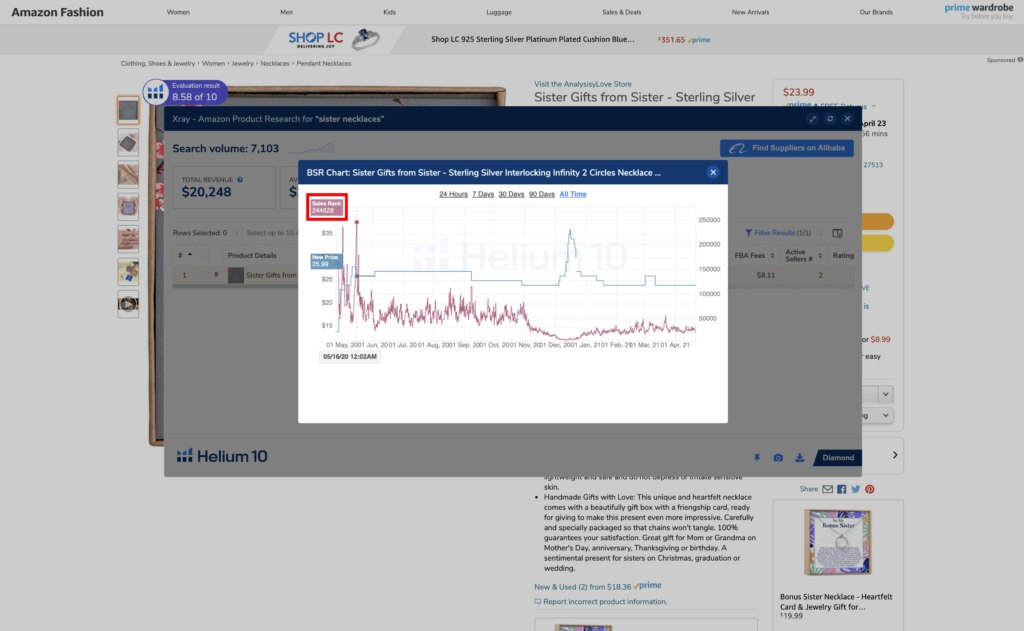
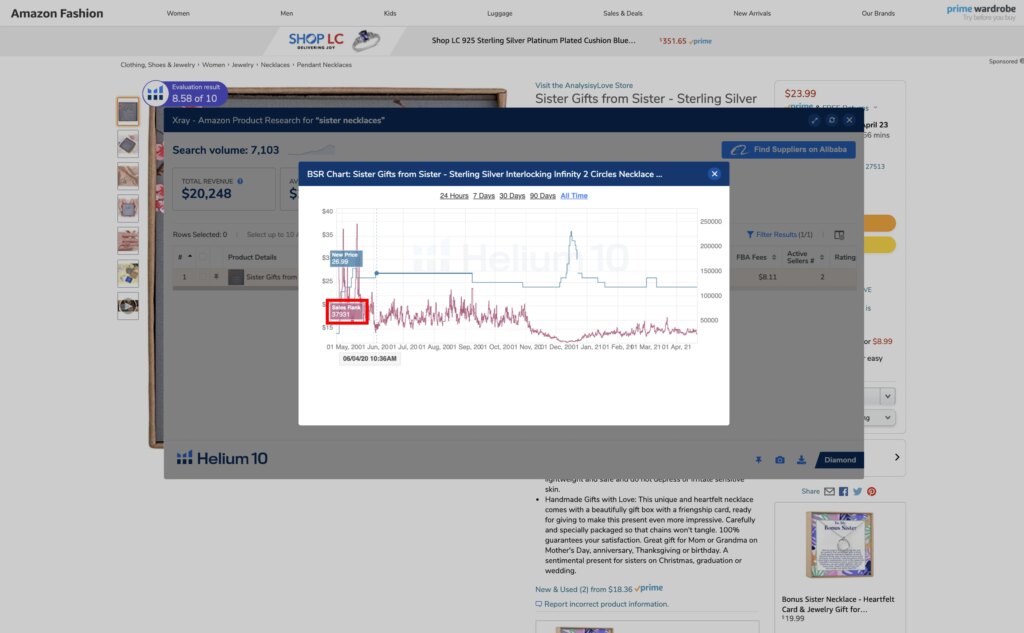
This by no way means I should 100% use the keyword for my own product if the “sister’s necklace” market was one I was interested in embarking upon. However, it’s clear that using historical data of Amazon sales rank can provide sellers with the insight and confidence needed to understand whether a certain keyword plays a role in increasing sales and lowering BSR.
Okay — if not BSR, then what?
Alright, rewind. Remember how at the beginning of this whole spiel, I mentioned that Bradley Sutton, our Director of Training here at Helium 10, loves to say how his own BSR is meaningless to him?
Well, if BSR provides such great insights on when your competitors run out of stock, when a product first launched, and keywords, why is that?
It’s because his belief is that as a brand owner, you already know how much you are selling from your Seller Central dashboard! What matters is your product sales, and you don’t need BSR to know that.
When it comes to competitors, Bradley is aware that he can simply use Helium 10 to discern what their estimated sales are. That’s a much more actionable metric than a BSR.
The best seller rank is a representation of how many units you are selling compared to the other products in your category. When BSR increases, it means lower sales, and lower BSR means higher sales.
Although many sellers focus on other competitors’ BSR, Bradley encourages Amazon sellers to focus on information such as how much or how many units are your competitors selling?
Want to be on top of page one for your main keywords? Outside of sales, Bradley believes there are two specific kinds of Amazon rankings to pay attention to instead.
Pay attention to your organic ranking. Organic Amazon product ranking is the placement of your product once it has been indexed in search results based on your sales history for main keywords that people find your listing for.
If BSR is a reactionary or something that happens after-sales, organic ranking can be what causes sales.
Another metric that we recommend watching is sponsored rank.
Sponsored rank varies depending on where the buyers are located, what their purchase history is, and factors like that. However, if you are running PPC, are trying to rank for a leg pillow, and your bid is at $2, but you are showing up on page three for that keyword for sponsored, then it could be a sign that you need to increase your bid. If that’s the case, everyone is probably outbidding you.
Keyword Tracking Best Practices
What’s the best part? You do not have to manually type in each keyword you are trying to rank for and scroll through the individual Amazon search result pages to locate your product for these rankings. You can easily track and monitor your position changes using one of Helium 10’s tools for Amazon sellers, Keyword Tracker.
Once you’ve added your product using the instructions from earlier in this article, just click on your product name and check the Organic Rank and Sponsored Rank columns to track your position.
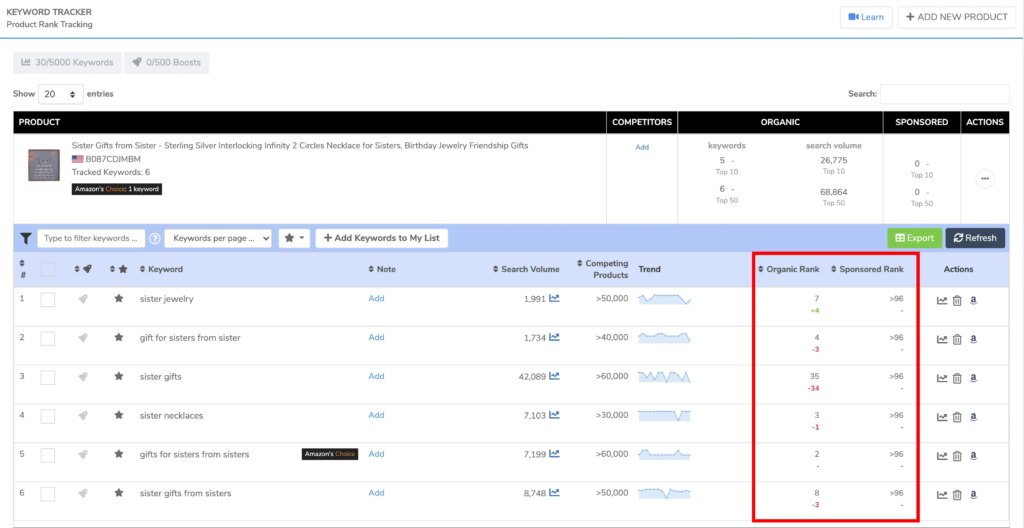
If your goal is to have your product show up as number one in the sponsored results, you need to track where your product is coming up with your sponsored rank before using Helium 10’s ADS. This will allow you to edit your bidding strategy as needed until your product is ranking for position one for sponsored.
Luckily, while Amazon doesn’t tell people what keywords are driving organic sales, you can still use this method to determine and conclude if a particular keyword will bring you sales.
Think about it logically. The only reason for a competitor to rank within the top 10 positions for a keyword with significant search volume is by converting for it. Therefore, if there is a product resembling yours ranking well for a high customer search volume keyword, you will want to make sure you have that keyword in your listing too.
Why? Because if that keyword could bring them a sale, odds are it will probably bring you one too.
Stay Vigilant
Since ranking affects where and when products appear in a customer’s search, it is common knowledge that most sellers try to boost their Amazon product rankings to be displayed on the first results page of a customer search results.
But when it comes down to real implementation, we encourage you to stay cautious of tools out there in which you can just enter a BSR to receive a sales estimate!
Yes, both of those things are correlated; however, because BSR is a metric of only temporary permanence, the tools that offer such insights are typically marked with inaccuracy.
A BSR represents a particular moment in time, and there is no product on Amazon that will keep the same BSR for an entire month. Furthermore, no Amazon product ranking — not organic, not sponsored, and certainly not BSR are impermeable to moving up and down naturally.
Accurate sales estimates can only be derived if the tool frequently looks at all of the changes, up and down, throughout the whole month.
So, stay mindful and ensure you are opting only for tools that provide you with a holistic view of your Amazon product rank!
After all, employing tools that (1) track keywords regularly, (2) let you stay on top of your product’s organic and sponsored rankings, and (3) remain focused on the metrics that really matter have the power to catalyze your business more efficiently and effectively than you might think.
Achieve More Results in Less Time
Accelerate the Growth of Your Business, Brand or Agency
Maximize your results and drive success faster with Helium 10’s full suite of Amazon and Walmart solutions.

